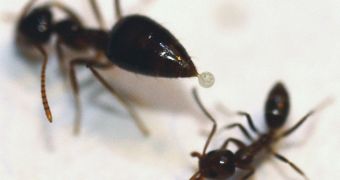Local ants on the Stanford University campus are apparently well-trained in the art of chemical warfare, as students discovered during a summer course. The small insects can deploy an entire arsenal of such weapons to fight off invading Argentine ants.
The invading South American species has made its way to nearly all continents, from America to Asia, including Europe, Africa and Australia. They can pose a real threat to ecosystems, throwing them in disarray as they remove native species.
But “plucky winter ants” at Stanford seem to have different plans, that do not include them being wiped out by invaders. Despite the fact that no other species in the world managed to withstand the Argentine onslaught, this one appears capable of doing so.
When placed under extreme stress, such as for example during a battle, the native ants can produce a chemical through a gland on their abdomen. The chemical is a potent poison, which boasts a staggering 79 percent kill rate.
A single, tiny droplet is sufficient to bring an Argentine ant to an early grave. “This is the first well-documented case where a native species is successfully resisting the Argentine ant,” Deborah M. Gordon explains.
The Stanford biology professor led the three-week summer class. Students attended the courses were the first to discover the ability winter ants had. The species is named thusly because it can function during the winter, rather than hibernating like most insects.
“I did not believe it at first. This is a group of ants that does not have a sting and you don't see them acting aggressively, but the students were able to show very clearly not just that the winter ants are using poison, but when they use it, how they use it and what the impact is,” Gordon says.
Details of the investigation and its conclusions appear in an issue of the peer-reviewed journal PLoS ONE, which was published by the Public Library of Science earlier this year.
“If you live in a Mediterranean climate, the Argentine ant is the ant in your kitchen. These ants, wherever they become established, wipe out all the native ants,” the Stanford expert explains.
“We were looking at the nest openings of the winter ants and one day it was just winter ants going about their business foraging for food and making trails – just typical ant behavior,” study coauthor and Stanford student Leah Kuritzky says.
“The next day we came back and the ground was littered with Argentine ants. There were dead ants all around and there was a lot of fighting around the nest entrances,” the student adds.
Using gas chromatography and mass spectrometry, experts found traces of a type of hydrocarbon generally used for intra-colony communication. But the active ingredient that makes the poison so effective has yet to be determined.

 14 DAY TRIAL //
14 DAY TRIAL //